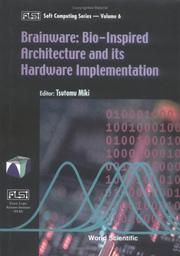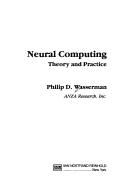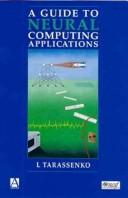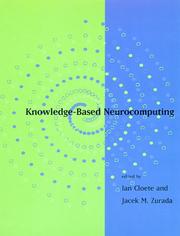| Listing 1 - 10 of 49 | << page >> |
Sort by
|
Book
Year: 1991 Publisher: Manchester New York Manchester University Press
Abstract | Keywords | Export | Availability | Bookmark
 Loading...
Loading...Choose an application
- Reference Manager
- EndNote
- RefWorks (Direct export to RefWorks)
Book
ISBN: 9781624175985 1624175988 9781613246993 1613246994 Year: 2012 Publisher: New York : Nova Science Publishers,
Abstract | Keywords | Export | Availability | Bookmark
 Loading...
Loading...Choose an application
- Reference Manager
- EndNote
- RefWorks (Direct export to RefWorks)
Neural computers. --- Neural net computers --- Neural network computers --- Neurocomputers --- Electronic digital computers --- Natural computation --- Artificial intelligence
Book
ISBN: 9811961344 9811961352 Year: 2022 Publisher: Singapore : Springer,
Abstract | Keywords | Export | Availability | Bookmark
 Loading...
Loading...Choose an application
- Reference Manager
- EndNote
- RefWorks (Direct export to RefWorks)
Neural computers. --- Neural net computers --- Neural network computers --- Neurocomputers --- Electronic digital computers --- Natural computation --- Artificial intelligence

ISBN: 1281951765 9786611951764 9812810250 9789812810250 9810245475 9789810245474 9781281951762 6611951768 Year: 2001 Publisher: Singapore River Edge, NJ World Scientific
Abstract | Keywords | Export | Availability | Bookmark
 Loading...
Loading...Choose an application
- Reference Manager
- EndNote
- RefWorks (Direct export to RefWorks)
The human brain, the ultimate intelligent processor, can handle ambiguous and uncertain information adequately. The implementation of such a human-brain architecture and function is called "brainware". Brainware is a candidate for the new tool that will realize a human-friendly computer society. As one of the LSI implementations of brainware, a "bio-inspired" hardware system is discussed in this book. Consisting of eight enriched versions of papers selected from IIZUKA '98, this volume provides wide coverage, from neuronal function devices to vision systems, chaotic systems, and also an effe
Computer architecture. --- Neural computers. --- Neural net computers --- Neural network computers --- Neurocomputers --- Electronic digital computers --- Natural computation --- Artificial intelligence --- Architecture, Computer
Book
ISBN: 0262011107 9780262255592 9780262511506 0262255596 9780262011105 Year: 1989 Publisher: Cambridge, Mass. : MIT Press,
Abstract | Keywords | Export | Availability | Bookmark
 Loading...
Loading...Choose an application
- Reference Manager
- EndNote
- RefWorks (Direct export to RefWorks)
"McClelland and Rumelhart's Parallel Distributed Processing was the first book to present a definitive account of the newly revived connectionist/neural net paradigm for artificial intelligence and cognitive science. While Neural Computing Architectures addresses the same issues, there is little overlap in the research it reports. These 18 contributions provide a timely and informative overview and synopsis of both pioneering and recent European connectionist research. Several chapters focus on cognitive modeling; however, most of the work covered revolves around abstract neural network theory or engineering applications, bringing important complementary perspectives to currently published work in PDP.In four parts, chapters take up neural computing from the classical perspective, including both foundational and current work; the mathematical perspective (of logic, automata theory, and probability theory), presenting less well-known work in which the neuron is modeled as a logic truth function that can be implemented in a direct way as a silicon read only memory. They present new material both in the form of analytical tools and models and as suggestions for implementation in optical form, and summarize the PDP perspective in a single extended chapter covering PDP theory, application, and speculation in US research. Each part is introduced by the editor."

ISBN: 9812778594 9789812778598 9789810240752 9810240759 Year: 2002 Publisher: River Edge, NJ ; London : World Scientific,
Abstract | Keywords | Export | Availability | Bookmark
 Loading...
Loading...Choose an application
- Reference Manager
- EndNote
- RefWorks (Direct export to RefWorks)
In order to develop new types of information media and technology, it is essential to model complex and flexible information processing in living systems. This book presents a new approach to modeling complex information processing in living systems. Traditional information-theoretic methods in neural networks are unified in one framework, i.e. a-entropy. This new approach will enable information systems such as computers to imitate and simulate human complex behavior and to uncover the deepest secrets of the human mind.
Neural computers. --- Neural networks (Computer science) --- Artificial neural networks --- Nets, Neural (Computer science) --- Networks, Neural (Computer science) --- Neural nets (Computer science) --- Artificial intelligence --- Natural computation --- Soft computing --- Neural net computers --- Neural network computers --- Neurocomputers --- Electronic digital computers

ISBN: 0442207433 9780442207434 Year: 1989 Publisher: New York (N.Y.) Van Nostrand Reinhold
Abstract | Keywords | Export | Availability | Bookmark
 Loading...
Loading...Choose an application
- Reference Manager
- EndNote
- RefWorks (Direct export to RefWorks)
Artificial intelligence. Robotics. Simulation. Graphics --- Computer architecture. Operating systems --- Neural computers. --- Ordinateurs neuronaux --- Neural computers --- 681.3*C1 --- Neural net computers --- Neural network computers --- Neurocomputers --- Electronic digital computers --- Natural computation --- Artificial intelligence --- Processor architectures (Computer systems organization) --- 681.3*C1 Processor architectures (Computer systems organization)
Book
ISBN: 0201500361 9780201500363 Year: 1990 Publisher: Reading, Massachusetts : Addison-Wesley publishing company,
Abstract | Keywords | Export | Availability | Bookmark
 Loading...
Loading...Choose an application
- Reference Manager
- EndNote
- RefWorks (Direct export to RefWorks)
Computer. Automation --- Neural networks (Computer science) --- Neural computers --- Neural computers. --- Artificial neural networks --- Nets, Neural (Computer science) --- Networks, Neural (Computer science) --- Neural nets (Computer science) --- Artificial intelligence --- Natural computation --- Soft computing --- Neural net computers --- Neural network computers --- Neurocomputers --- Electronic digital computers --- Neural networks (Computer science). --- Neural networks (computer science) --- Réseaux neuronaux (informatique) --- Ordinateurs neuronaux --- Ordinateurs neuronaux.

ISBN: 1281049972 9786611049973 0080512607 9780080512600 9780340705896 0340705892 0471255505 9780471255505 9781281049971 6611049975 Year: 1998 Publisher: London : New York : Arnold ; Co-published in North, Central, and South America by John Wiley,
Abstract | Keywords | Export | Availability | Bookmark
 Loading...
Loading...Choose an application
- Reference Manager
- EndNote
- RefWorks (Direct export to RefWorks)
Neural networks have shown enormous potential for commercial exploitation over the last few years but it is easy to overestimate their capabilities. A few simple algorithms will learn relationships between cause and effect or organise large volumes of data into orderly and informative patterns but they cannot solve every problem and consequently their application must be chosen carefully and appropriately.This book outlines how best to make use of neural networks. It enables newcomers to the technology to construct robust and meaningful non-linear models and classifiers and benefits th
Neural computers. --- Neural networks (Computer science) Neural computers. --- Neural networks (Computer science) --- Neural computers --- Engineering & Applied Sciences --- Computer Science --- Neural net computers --- Neural network computers --- Neurocomputers --- Artificial neural networks --- Nets, Neural (Computer science) --- Networks, Neural (Computer science) --- Neural nets (Computer science) --- Electronic digital computers --- Natural computation --- Artificial intelligence --- Soft computing --- Neural Networks (Computer)

ISBN: 0262032740 0262528738 0262270498 0585355010 9780262270496 9780262032742 9780585355016 9780262528733 Year: 1999 Publisher: Cambridge, Massachusetts : The MIT Press,
Abstract | Keywords | Export | Availability | Bookmark
 Loading...
Loading...Choose an application
- Reference Manager
- EndNote
- RefWorks (Direct export to RefWorks)
Looking at ways to encode prior knowledge and to extract, refine, and revise knowledge within a neurocomputing system.Neurocomputing methods are loosely based on a model of the brain as a network of simple interconnected processing elements corresponding to neurons. These methods derive their power from the collective processing of artificial neurons, the chief advantage being that such systems can learn and adapt to a changing environment. In knowledge-based neurocomputing, the emphasis is on the use and representation of knowledge about an application. Explicit modeling of the knowledge represented by such a system remains a major research topic. The reason is that humans find it difficult to interpret the numeric representation of a neural network.The key assumption of knowledge-based neurocomputing is that knowledge is obtainable from, or can be represented by, a neurocomputing system in a form that humans can understand. That is, the knowledge embedded in the neurocomputing system can also be represented in a symbolic or well-structured form, such as Boolean functions, automata, rules, or other familiar ways. The focus of knowledge-based computing is on methods to encode prior knowledge and to extract, refine, and revise knowledge within a neurocomputing system.ContributorsC. Aldrich, J. Cervenka, I. Cloete, R.A. Cozzio, R. Drossu, J. Fletcher, C.L. Giles, F.S. Gouws, M. Hilario, M. Ishikawa, A. Lozowski, Z. Obradovic, C.W. Omlin, M. Riedmiller, P. Romero, G.P.J. Schmitz, J. Sima, A. Sperduti, M. Spott, J. Weisbrod, J.M. Zurada
Expert systems (Computer science) --- Neural computers. --- #TELE:SISTA --- Neural net computers --- Neural network computers --- Neurocomputers --- Electronic digital computers --- Natural computation --- Artificial intelligence --- Knowledge-based systems (Computer science) --- Systems, Expert (Computer science) --- Computer systems --- Soft computing --- Engineering & Applied Sciences --- Computer Science --- Neural computers --- COMPUTER SCIENCE/General
| Listing 1 - 10 of 49 | << page >> |
Sort by
|

 Search
Search Feedback
Feedback About
About Help
Help News
News